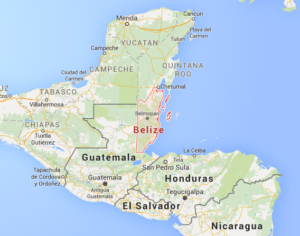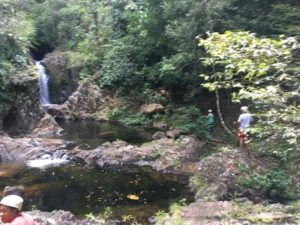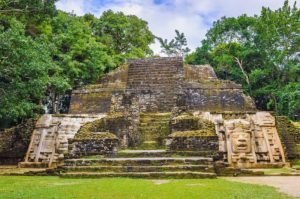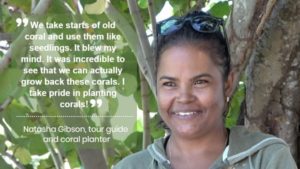|
Getting your Trinity Audio player ready...
|
Reading Time 8 mins
December 30, 2021
A beautiful creek runs across the 400-acre estate where I live in Belize, a nation of some 400,000 people, locked between Mexico to the north, Guatemala to the west, and Honduras to the south, on the Caribbean Coast.

The creek originates in the mountains with five cascading waterfalls, only accessible by hiking for two hours upstream along a narrow valley. There is nothing but tropical forest for miles on either side; a jungle inhabited by countless little animals; wild pigs that run in highly dangerous packs; agile deer; a few lumbering tapirs; and the occasional jaguar. Soaring above all of this are the noisy, elusive, and spectacularly beautiful macaws and fluttering between the trees are an infinite variety of birds and butterflies.
As you hike up the creek, you will see some huge rocks in the valley walls composed of layers of material in slabs cocked at sharp angles from the horizontal. Think about it: these are sedimentary rocks, and sediment is sand and mud that have settled at the bottom of bodies of water. Sand forms by the erosion of stones by flowing water. So how are these huge sedimentary slabs on the banks of a creek running through a valley hundreds of feet above sea level?
You are hiking through an environment that has been millions of years in the making. This land was flat, and the rain fell upon it, and the water ran across it in streams, pushing little stones that ground giant rocks into sand which settled at the bottom of enormous lakes, layer after layer, for thousands of years. And as the layers thickened, the pressure turned the layers of sand back into flat sedimentary rock.
Then massive earthquakes broke up these sedimentary rocks, and the surface of the Earth buckled and pushed up to form mountains with the flat slabs of rock at odd angles. And for thousands more years, the rain fell on these mountains, and the streams again carved their way through the rocks, grinding them down into the sand, wearing away the banks, and thus creating ever broader and deeper valleys.
“There isn’t another place on this planet quite like Belize, and notwithstanding the negatives…. the future looks promising.”
And so it is you find yourself standing in a creek at the bottom of a valley staring at eons-old sedimentary rocks lying at odd angles and trying to make sense of it all. And then, a few questions come to mind: how did you get here? Whence did you come to be in this place? Where do you fit into the story of this valley and, indeed, of this planet?
These rocks are millions of years old. This valley was carved out long before any people were on Earth. For a hundred thousand years, the animals I have described above have been roaming these forests unmolested until, about fifteen thousand years ago, humans arrived: ancestors of mine who, generation after generation, had trudged from the land we now call Siberia, evolving, as they went, the beautiful reddish skin and other distinctive features that we now call Amerindian.
Here they foraged and hunted to survive, killing out the last of a few giant animals that they encountered. Then they learned how to plant crops and make pottery, and they settled into villages which grew into cities, and empires emerged with millions of subjects. And then, their priests commanded that they build astronomical observatories and magnificent temples in the shape of pyramids. And the animals retreated into the forests. Waiting as if they knew all of this would come to nothing.
And so it did. There were droughts and famines, wars and rebellions, and the mighty empires collapsed. Then the Europeans, my other ancestors, arrived in boats with gunpowder and horses, and worst of all, strange diseases that could wipe out a whole village in months.
Between the guns and the diseases, the entire population of what is now Belize disappeared. The European ships brought slaves, my ancestors, European peasants, and indentured servants from India. Then the indigenes returned from the lands to the north and the west; the Garifuna and others came from the Caribbean islands. And finally, there came Mennonites of Germanic origin and merchants from China and India. And the animals in the forests are watching and waiting to see what will come from this.
Today, half of the Afro-Belizeans have emigrated to the USA, thousands of Hispanics and Mestizos have immigrated from the surrounding nations, and hundreds of Euro-Americans have made Belize their home. From a population of less than a hundred thousand a century ago, Belize has grown four times in size, an oasis in Central America of relative peace, racial harmony, political stability, and reasonable economic progress. The negative aspects are the usual legacies of colonialism – prejudiced elites, urban ghettos, a raucous parliament with shortsighted politicians, and, primarily spawned by the transshipment of drugs, violent gangs, and a corrupted economy.
There isn’t another place on this planet quite like Belize, and the future looks promising despite the negatives above. However, the major threats are primarily external and potentially overwhelming; to wit: the climate crisis and especially the drought it has brought to the region, the growing desperation of the poor in neighboring countries, the continuous wash of drugs flowing from South to North America, and significant vulnerability to global economic instability.
Standing in a creek staring at million-year-old rocks and watched by animals that have seen civilizations come and go, it is not too difficult to accept that time is on their side. Fifteen thousand years is just a moment in a universe that is billions of years old, with billions more to go before the Sun, who the Mayans presciently worshipped, blows up and brings all the stories on this planet to an end.
Those isolated Central American civilizations only lasted for a few thousand years overall. Perhaps this recent universal civilization will last a lot longer and maybe even allow people – or human-machine hybrids – to voyage to other star systems and thus survive the demise of this one. Perhaps.
It seems more likely that it will implode, leaving scattered groups of people again foraging and hunting in a badly scarred environment beyond human manipulation. In other words, we will be back to where we were fifteen thousand years ago, only this time, the natural resources to build civilizations would not be so readily available. For example, we have removed most surface iron ore in our push to modernity so that another Iron Age may be impossible.
In our religious fantasies, humanity is at the center of a universe created specifically for us to worship its creator and stage sacrifices to earn his favor. That was an understanding when all we could see above us was the sky, which is still good enough for most people. They are content to leave the climate crisis in God’s hands, confident that he will not allow his children to disappear.
It must be nice to be so sure about the future: where ignorance is bliss, ’tis indeed folly to be wise. It is easier to believe that those rocks I am staring at are only six thousand years old and that humanity is just at the beginning of a glorious era that will soon be followed by eternal life in a better place, though only for those who have lived a righteous life in this world.
It might be easier, but I now know that billions of other planets exist in a big universe beyond human comprehension. And those animals in the forest know that a human is just another animal, albeit full of hubris and given to wild behavior that often destroys the very environs in which it must live. And so they watch our antics and wait.
For the first time in human history, it is entirely plausible that humanity is just a curious little phenomenon in an insignificant little place that will only have lasted for a moment in time. So it was inevitable that humans would come to this cosmic understanding – although it is still limited to a very, very small minority that has the necessary information (nothing mystical: physics, chemistry, biology, geology, archaeology, anthropology, astronomy, and a commensurate level of literacy).
The evolution of language hundreds of thousands of years ago was the first step. Consciousness had long emerged from the complexity of animal nervous systems, but human mental capacity, and hence our level of consciousness, far outpaced that of other animals. Then we learned not just how to think but how to think about thinking. Our capacity for abstraction allowed us to transcend the circumstances prescribed by our genes. Ideas, in other words, became the prime mover in the history of our species. A human is the only animal that can discuss its predicament and act on the ideas generated by that discussion – although, too often, our animal instincts sabotage the ideas.
Unsurprisingly, humans decided that they were specially created, which meant that there had to be a creator and that we had a special responsibility to define how we ought and should not live. And so “ought” became the defining concept for human societies and opinion, the curse with which we, alone among the animals, have to contend.
That, in my opinion, is as far as we have reached, and I see no indication that we are making much progress. We have slowly and painfully agreed on specific Universal Human Rights, and more people are now concerned about their freedoms than ever before. But we are far from a world where these issues are central to our thinking. Our selfish genes are still the primary determining factor in our behavior, and our differing opinions are a significant source of conflict.
Science and technology have transformed our physical environment in unsustainable ways, and most people have accepted this as the price of progress, for the comforts and the conveniences are irresistible. There is undoubtedly a growing awareness of its unsustainability, but I have a nasty feeling that it is too late. From a human perspective, not only may we have damaged the environment beyond repair, but our response to the pandemic has shown how many people are not prepared to face reality.
Of course, the Earth will recover, and other animals will eventually reclaim their habitats and thrive again – but only after we are gone. It was astonishing to see how quickly wild beasts appeared on the empty streets of rural towns at the height of the pandemic lockdowns. They seem impatient for the human story to come to a long-anticipated end. Now that is something to think about the next time I hike up the creek.
 Dr. Geoffrey Frankson is a Belize National Scholar and a medical graduate of the University of the West Indies. He studied Human Sciences at Oxford University on a Rhodes Scholarship and was voted a Caribbean Luminary in 2007 by the American Foundation for The University of the West Indies. Since 2017 he has been managing the family farm, Rancho Lomas, a citrus estate of some 400 acres just south of Belmopan, the capital of Belize.
Dr. Geoffrey Frankson is a Belize National Scholar and a medical graduate of the University of the West Indies. He studied Human Sciences at Oxford University on a Rhodes Scholarship and was voted a Caribbean Luminary in 2007 by the American Foundation for The University of the West Indies. Since 2017 he has been managing the family farm, Rancho Lomas, a citrus estate of some 400 acres just south of Belmopan, the capital of Belize.




A very informative article. I hope that he has not given up on his medical pronouncements which were often unorthodox – to to layperson – but, again, informative.